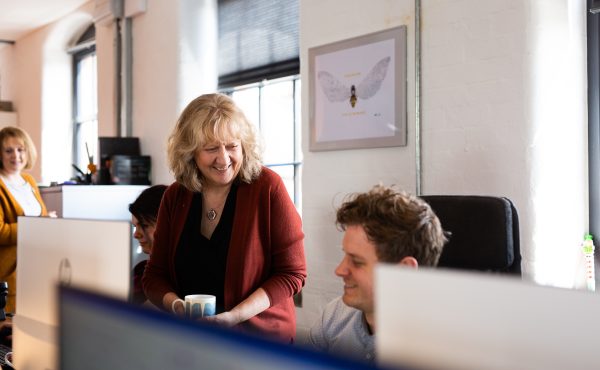If we can take anything positive from the challenges most employees and businesses experienced during the pandemic, it’s the increased awareness of general wellbeing – and especially the impact that work can have. Wellbeing has become so important that the ONS introduced a new question to its population survey asking people how satisfied they are with their life as a way of evaluating the UK’s progress. This is intended to complement data sets focused on economic growth (typically measured as Gross Domestic Product – GDP). The data released in May 2024 shows that those reporting low satisfaction has increased by 5.8% over the five-year period up to December 2023. As part of our Good Employer’s Journey, we worked on building more robust policies around promoting employee health and wellbeing, which we will discuss further in the final blog of our The Greater Manchester Good Employment Charter (GEC) series.
Our Good Employment Charter series is based on its seven key principles. You can visit the other topics we’ve covered by clicking the links below:
Point 1 (Secure Work) in GEC 1 – The Principles We Live By
Points 2 and 3 (Flexible Work and Pay) in GEC 2 – Achieving the Work-Life Balance
Point 4 (Engagement and Voice) in GEC 3 – Is it Good to Speak Your Mind at Work?
Point 5 and 6 (Recruitment and People Management) in GEC 4 – A Company People Want To Work For.
What is workplace wellbeing?
Workplace wellbeing is when an employer effectively creates an internal culture that promotes and prioritises its team’s physical and mental health. This can be achieved in a number of ways but should also include policies and practices that formalise employee wellbeing support, such as through Employee Assistance Programmes (EAP) and ongoing training. You can learn more about a holistic approach to wellbeing via CIPD and its worksheets.
Why is wellbeing important in the workplace?
There are 168 hours in a week, but a full-time employee will spend at least 35 hours of this in the workplace. This is before we consider other demands on an individual’s time, such as sleep, commuting, family, housework, cooking, caring responsibilities, and social connection. There are already a lot of potentially stressful scenarios to navigate, but imagine how much more complicated this gets if we also factor in additional challenges, such as chronic pain, long-term illness or mental health difficulties.
When we prioritise wellbeing in the workplace, we’re acknowledging that employees are people first. That their mental and physical health is important. By embedding this ethos into your business, you create a space in which your employees feel valued and empowered in how they approach health inside and outside of work. This, in turn, has the potential to improve measures that directly benefit business too, such as productivity, engagement, and retention which can lead to the long-term success of the business.
What does the Good Employment Charter say about ‘health and wellbeing’?
According to the GEC, “Greater Manchester’s employees spend a minimum of 60% of their waking hours at work”. It notes that, for many workplaces, this means limited physical activity which can lead to a high risk of health problems, in addition to the impact on stress and mental health. It states that Supporters of the Charter should make the following commitment:
“We support the mental and physical health of all our employees, including adjustments for people with long-term conditions and disabilities, delivering high standards of health and safety in the workplace, and so reducing the costs of absences and providing the benefits of a more diverse workforce.”
Smith Goodfellow’s approach to a good place to work
Our senior leaders are committed to developing a culture where employees can take ownership of both their role and help to contribute to a healthy and productive workplace.
What we do
Some of the key points extracted from our application to the Good Employment Charter on how we approach health and wellbeing.
- We monitor staff wellbeing through absence records, return to work interviews and regular wellbeing check-ins conducted on a 1:1 basis through monthly line management meetings. Through these processes, we are then able to respond to employee’s wellbeing needs – for example, by revisiting working arrangements to facilitate home working when employees were feeling anxious about returning to an office environment after the pandemic and extending the remit of our employee fund to cover wellbeing support such as counselling as well as training and development needs.
- We acknowledge the changing needs and challenges that accompany different stages of life and support staff to thrive whatever their personal circumstances, including adjusting for those living with long-term health conditions and mental health difficulties and those with childcare responsibilities.
- For employees struggling with mental health difficulties/long term health conditions we have made a variety of adjustments, including agreeing later starting times when sleep is disrupted by their condition, having things like heatable wheat packs available in the office to help alleviate pain symptoms if a flare up occurs at work and checking that things like chair/desk arrangements are ergonomic and comfortable to accommodate any physical needs.
- We recognise mental health as a health and wellbeing issue and offer a range of support to promote positive mental health and remove stigma, including access to a wellbeing hub with articles and meditation exercises, and supporting employees to access counselling if needed and desired through an Employee Assistance Programme (EAP) with a local counselling service.
- We also regularly review our team’s workload through weekly meetings and do our utmost to ensure that workload does not create an undue burden of stress on any individual. If any team member is struggling with their workload, we will look to reallocate work or renegotiate deadlines wherever possible to relieve pressure points. Recognising the importance of mental health as essential to enabling employees to thrive is central to our people-first approach and organisational culture.
- When people are working from home, we ensure we have regular check ins online – either direct messages or video call depending on preference. We also monitor when people have been active online on work platforms, such as email and Slack, to ensure that employees are not working in their own time. If we see any unanticipated overtime activity, a member of the management team will get in touch with them to see what work they can be relieved of so they are not needing to work out of hours. If we have any concerns, we will encourage the employee to come into the office when feasible for a face-to-face catch up so we can establish whether any support is needed.
- We have a ‘shit happens’ policy whereby if employees are faced with unexpected personal issues – such as a flat tyre/breakdown, burst pipe, broken boiler etc – they do not need to take annual leave or sacrifice pay to deal with it. We acknowledge that these situations are sometimes unavoidable, and we want our staff to feel supported in being able to deal with the day-to-day complications that sometimes arise, without being penalised for it. In addition to the above, we also have an employee perks programme (Perkbox) which has a variety of free health and wellbeing resources, such as fitness and mental health videos, in addition to discounts for gym memberships and subscriptions to healthy meal boxes.
- The business also provides a variety of beverages to ensure the team is well hydrated. In addition, snacks including healthier options and fruit, are regularly supplied to support a variety of diet and lifestyle choices.
Is Smith Goodfellow a good place to work? – An employee’s view
“I began working for Smith Goodfellow over 10 years ago. When I started, we were a much smaller team and had fewer policies. In my interview, the management team talked about their vision for the type of work culture and business they wanted to grow, which was shaped around the team’s needs and ambitions.
In those 10 years, not only has the business changed and grown to adapt to an increasingly difficult world, but it has continued to evolve internally too. As I’m now a decade older, I’ve had to adjust to the challenges that inevitably come with aging or navigating life experiences in general. I’m grateful to be in a workplace that does its best to support its team whatever stage they’re at, whether that be through flexible working, eye tests, or counselling support.” – Kelly Oldham, Senior Account Executive
If you’d like to discuss any of the content in these blogs or talk about your own experiences with us, you can find us on these social channels: Instagram, LinkedIn, Facebook, and Threads.
Learn more about our history as a PR and marketing consultancy that specialises in construction.
DISCLAIMER: This is based on our experience and is not endorsed by GEC, nor does it offer any guarantees. Please view the Greater Manchester Good Employment Charter FAQs or contact them directly to discuss how your business can become a Supporter or apply for membership.





